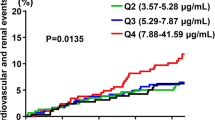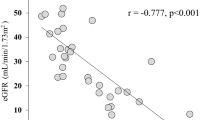Abstract
Resistant hypertension (RHTN) includes patients with controlled blood pressure (BP) (CRHTN) and uncontrolled BP (UCRHTN). In fact, RHTN patients are more likely to have target organ damage (TOD), and resistin, leptin and adiponectin may affect BP control in these subjects. We assessed the relationship between adipokines levels and arterial stiffness, left ventricular hypertrophy (LVH) and microalbuminuria (MA). This cross-sectional study included CRHTN (n=51) and UCRHTN (n=38) patients for evaluating body mass index, ambulatory blood pressure monitoring, plasma adiponectin, leptin and resistin concentrations, pulse wave velocity (PWV), MA and echocardiography. Leptin and resistin levels were higher in UCRHTN, whereas adiponectin levels were lower in this same subgroup. Similarly, arterial stiffness, LVH and MA were higher in UCRHTN subgroup. Adiponectin levels negatively correlated with PWV (r=−0.42, P<0.01), and MA (r=−0.48, P<0.01) only in UCRHTN. Leptin was positively correlated with PWV (r=0.37, P=0.02) in UCRHTN subgroup, whereas resistin was not correlated with TOD in both subgroups. Adiponectin is associated with arterial stiffness and renal injury in UCRHTN patients, whereas leptin is associated with arterial stiffness in the same subgroup. Taken together, our results showed that those adipokines may contribute to vascular and renal damage in UCRHTN patients.
This is a preview of subscription content, access via your institution
Access options
Subscribe to this journal
Receive 12 digital issues and online access to articles
$119.00 per year
only $9.92 per issue
Buy this article
- Purchase on Springer Link
- Instant access to full article PDF
Prices may be subject to local taxes which are calculated during checkout


Similar content being viewed by others
References
Calhoun DA, Jones D, Textor S, Goff DC, Murphy TP, Toto RD et al. Resistant hypertension: diagnosis, evaluation, and treatment: a scientific statement from the American Heart Association Professional Education Committee of the Council for High Blood Pressure Research. Circulation 2008; 117: e510–e526.
Vakili BA, Okin PM, Devereux RB . Prognostic implications of left ventricular hypertrophy. Am Heart J 2001; 141: 334–341.
Vlek AL, van der Graaf Y, Spiering W, Algra A, Visseren FL . Cardiovascular events and all-cause mortality by albuminuria and decreased glomerular filtration rate in patients with vascular disease. J Intern Med 2008; 264: 351–360.
Laurent S, Boutouyrie P, Asmar R, Gautier I, Laloux B, Guize L et al. Aortic stiffness is an independent predictor of all-cause and cardiovascular mortality in hypertensive patients. Hypertension 2001; 37: 1236–1241.
Martins LC, Figueiredo VN, Quinaglia T, Boer-Martins L, Yugar-Toledo JC, Martin JF et al. Characteristics of resistant hypertension: ageing, body mass index, hyperaldosteronism, cardiac hypertrophy and vascular stiffness. J Hum Hypertens 2011; 25: 532–538.
Quinaglia T, Martins LC, Figueiredo VN, Santos RC, Yugar-Toledo JC, Martin JF et al. Non-dipping pattern relates to endothelial dysfunction in patients with uncontrolled resistant hypertension. J Hum Hypertens 2011; 25: 656–664.
Fonseca-Alaniz MH, Takada J, Alonso-Vale MI, Lima FB . Adipose tissue as an endocrine organ: from theory to practice. J Pediatr (Rio J) 2007; 83: S192–S203.
Chow WS, Cheung BM, Tso AW, Xu A, Wat NM, Fong CH et al. Hypoadiponectinemia as a predictor for the development of hypertension: a 5-year prospective study. Hypertension 2007; 49: 1455–1461.
Schutte R, Huisman HW, Schutte AE, Malan NT . Leptin is independently associated with systolic blood pressure, pulse pressure and arterial compliance in hypertensive African women with increased adiposity: the POWIRS study. J Hum Hypertens 2005; 19: 535–541.
Zhang L, Curhan GC, Forman JP . Plasma resistin levels associate with risk for hypertension among nondiabetic women. J Am Soc Nephrol 2010; 21: 1185–1191.
Fang C, Lei J, Zhou SX, Zhang YL, Yuan GY, Wang JF . Association of higher resistin levels with inflammatory activation and endothelial dysfunction in patients with essential hypertension. Chin Med J (Engl) 2013; 126: 646–649.
Youn JC, Kim C, Park S, Lee SH, Kang SM, Choi D et al. Adiponectin and progression of arterial stiffness in hypertensive patients. Int J Cardiol 2011; 163 (3): 316–319.
Hong SJ, Park CG, Seo HS, Oh DJ, Ro YM . Associations among plasma adiponectin, hypertension, left ventricular diastolic function and left ventricular mass index. Blood Press 2004; 13: 236–242.
Wannamethee SG, Tchernova J, Whincup P, Lowe GD, Kelly A, Rumley A et al. Plasma leptin: associations with metabolic, inflammatory and haemostatic risk factors for cardiovascular disease. Atherosclerosis 2007; 191: 418–426.
Zhu W, Cheng KK, Vanhoutte PM, Lam KS, Xu A . Vascular effects of adiponectin: molecular mechanisms and potential therapeutic intervention. Clin Sci (Lond) 2008; 114: 361–374.
Kartal O, Inal V, Baysan O, Saglam K . Relationship between serum leptin levels and left ventricular hypertrophy in obese hypertensive patients. Anatol J Cardiol 2008; 8: 342–346.
Schutte AE, Huisman HW, Schutte R, van Rooyen JM, Malan L, Fourie CMT et al. Adipokines and cardiometabolic function: How are they interlinked? Regul Peptides 2010; 164: 133–138.
de Haro Moraes C, Figueiredo VN, de Faria AP, Barbaro NR, Sabbatini AR, Quinaglia T et al. High-circulating leptin levels are associated with increased blood pressure in uncontrolled resistant hypertension. J Hum Hypertens 2013; 27: 225–230.
de Faria APC, Demacq C, Figueiredo VN, Moraes CH, Santos RC, Sabbatini AR et al. Hypoadiponectinemia and aldosterone excess are associated with lack of blood pressure control in subjects with resistant hypertension. Hypertens Res 2013; 36: 1067–1072.
Laurent S, Cockcroft J, Van Bortel L, Boutouyrie P, Giannattasio C, Hayoz D et al. Expert consensus document on arterial stiffness: methodological issues and clinical applications. Eur Heart J 2006; 27: 2588–2605.
Lang RM, Bierig M, Devereux RB, Flachskampf FA, Foster E, Pellikka PA et al. Recommendations for chamber quantification: a report from the American Society of Echocardiography’s Guidelines and Standards Committee and the Chamber Quantification Writing Group, developed in conjunction with the European Association of Echocardiography, a branch of the European Society of Cardiology. J Am Soc Echocardiogr 2005; 18 (12): 1440–1463.
Obesity: preventing and managing the global epidemic. Report of a WHO consultation. World Health Organ Tech Rep Ser 2000; 894: i–xii, 1–253.
Ehrhart-Bornstein M, Arakelyan K, Krug AW, Scherbaum WA, Bornstein SR . Fat cells may be the obesity-hypertension link: human adipogenic factors stimulate aldosterone secretion from adrenocortical cells. Endocr Res 2004; 30: 865–870.
Kadowaki T, Yamauchi T . Adiponectin and adiponectin receptors. Endocr Rev 2005; 26: 439–451.
Zieman SJ, Melenovsky V, Kass DA . Mechanisms, pathophysiology, and therapy of arterial stiffness. Arterioscler Thromb Vasc Biol 2005; 25: 932–943.
Tsioufis C, Dimitriadis K, Chatzis D, Vasiliadou C, Tousoulis D, Papademetriou V et al. Relation of microalbuminuria to adiponectin and augmented C-reactive protein levels in men with essential hypertension. Am J Cardiol 2005; 96: 946–951.
Tesauro M, Mascali A, Franzese O, Cipriani S, Cardillo C, Di Daniele N . Chronic kidney disease, obesity, and hypertension: the role of leptin and adiponectin. Int J Hypertens 2012; 2012: 943605.
Meyer C, Robson D, Rackovsky N, Nadkarni V, Gerich J . Role of the kidney in human leptin metabolism. Am J Physiol 1997; 273: E903–E907.
Pladevall M, Williams K, Guyer H, Sadurni J, Falces C, Ribes A et al. The association between leptin and left ventricular hypertrophy: a population-based cross-sectional study. J Hypertens 2003; 21: 1467–1473.
Bokarewa M, Nagaev I, Dahlberg L, Smith U, Tarkowski A . Resistin an adipokine with potent proinflammatory properties. J Immunol 2005; 174: 5789–5795.
Windham BG, Griswold ME, Farasat SM, Ling SM, Carlson O, Egan JM et al. Influence of leptin, adiponectin, and resistin on the association between abdominal adiposity and arterial stiffness. Am J Hypertens 2010; 23: 501–507.
Zorad S, Dou JT, Benicky J, Hutanu D, Tybitanclova K, Zhou J et al. Long-term angiotensin II AT(1) receptor inhibition produces adipose tissue hypotrophy accompanied by increased expression of adiponectin and PPAR-gamma. Eur J Pharmacol 2006; 552: 112–122.
Koh KK, Quon MJ, Han SH, Lee Y, Kim SJ, Koh Y et al. Distinct vascular and metabolic effects of different classes of anti-hypertensive drugs. Int J Cardiol 2010; 140: 73–81.
Ubaid-Girioli S, Ferreira-Melo SE, Souza LA, Nogueira EA, Yugar-Toledo JC, Coca A et al. Aldosterone escape with diuretic or angiotensin-converting enzyme inhibitor/angiotensin II receptor blocker combination therapy in patients with mild to moderate hypertension. J Clin Hypertens (Greenwich) 2007; 9: 770–774.
Sowers JR, Whaley-Connell A, Epstein M . Narrative review: the emerging clinical implications of the role of aldosterone in the metabolic syndrome and resistant hypertension. Ann Intern Med 2009; 150: 776–783.
Acknowledgements
This study was supported by the State of São Paulo Research Foundation (FAPESP), SP, Brazil, National Council for Scientific and Technological Development (CNPq) and Coordination for Improvement of Higher Education Personnel (Capes), Brazil.
Author information
Authors and Affiliations
Corresponding author
Ethics declarations
Competing interests
The authors declare no conflict of interest.
Rights and permissions
About this article
Cite this article
Sabbatini, A., Faria, A., Barbaro, N. et al. Deregulation of adipokines related to target organ damage on resistant hypertension. J Hum Hypertens 28, 388–392 (2014). https://doi.org/10.1038/jhh.2013.118
Received:
Revised:
Accepted:
Published:
Issue Date:
DOI: https://doi.org/10.1038/jhh.2013.118
Keywords
This article is cited by
-
Relationship between circulating leptin levels and arterial stiffness: a systematic review and meta-analysis of observational studies
High Blood Pressure & Cardiovascular Prevention (2020)
-
Pro-inflammatory Cytokines and Resistant Hypertension: Potential for Novel Treatments?
Current Hypertension Reports (2019)
-
Association of serum leptin levels with central arterial stiffness in coronary artery disease patients
BMC Cardiovascular Disorders (2016)
-
Positive correlation of serum adipocyte fatty acid binding protein levels with carotid–femoral pulse wave velocity in geriatric population
BMC Geriatrics (2015)
-
Adipokines: another link between obesity and hypertension
Journal of Human Hypertension (2015)



